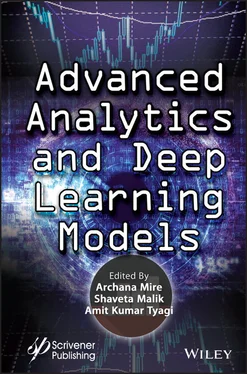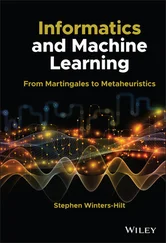Advanced Analytics and Deep Learning Models
Здесь есть возможность читать онлайн «Advanced Analytics and Deep Learning Models» — ознакомительный отрывок электронной книги совершенно бесплатно, а после прочтения отрывка купить полную версию. В некоторых случаях можно слушать аудио, скачать через торрент в формате fb2 и присутствует краткое содержание. Жанр: unrecognised, на английском языке. Описание произведения, (предисловие) а так же отзывы посетителей доступны на портале библиотеки ЛибКат.
- Название:Advanced Analytics and Deep Learning Models
- Автор:
- Жанр:
- Год:неизвестен
- ISBN:нет данных
- Рейтинг книги:5 / 5. Голосов: 1
-
Избранное:Добавить в избранное
- Отзывы:
-
Ваша оценка:
- 100
- 1
- 2
- 3
- 4
- 5
Advanced Analytics and Deep Learning Models: краткое содержание, описание и аннотация
Предлагаем к чтению аннотацию, описание, краткое содержание или предисловие (зависит от того, что написал сам автор книги «Advanced Analytics and Deep Learning Models»). Если вы не нашли необходимую информацию о книге — напишите в комментариях, мы постараемся отыскать её.
The book provides readers with an in-depth understanding of concepts and technologies related to the importance of analytics and deep learning in many useful real-world applications such as e-healthcare, transportation, agriculture, stock market, etc.
Audience
Advanced Analytics and Deep Learning Models — читать онлайн ознакомительный отрывок
Ниже представлен текст книги, разбитый по страницам. Система сохранения места последней прочитанной страницы, позволяет с удобством читать онлайн бесплатно книгу «Advanced Analytics and Deep Learning Models», без необходимости каждый раз заново искать на чём Вы остановились. Поставьте закладку, и сможете в любой момент перейти на страницу, на которой закончили чтение.
Интервал:
Закладка:
Library of Congress Cataloging-in-Publication Data
ISBN 978-1-119-79175-1
Cover image: Pixabay.ComCover design by Russell Richardson
Set in size of 11pt and Minion Pro by Manila Typesetting Company, Makati, Philippines
Printed in the USA
10 9 8 7 6 5 4 3 2 1
Preface
Advanced analytics is a mixture of machine learning, artificial intelligence, graphs, text mining, data mining, semantic analysis. It is an approach to data analysis. Beyond the traditional business intelligence, it is a semi and autonomous analysis of data by using different techniques and tools. However, deep learning and data analysis both are the high centres of data science. Almost all the private and public organizations collect heavy amounts of data, i.e., domain specific data. Many small/large companies are exploring large amounts of data for existing and future technology. Deep learning is also exploring large amounts of unsupervised data.
In fact, it is a key benefit of big data. It is also effective for big data. Moreover, it is collecting an unlabelled and uncategorized raw data. There are some challenges also in big data related to the extraction complex patterns from the large amount of data, retrieving of fast information, tagging of data etc, deep learning can be used to deal these kinds of problems or challenges.
The purpose of this book is to help teachers to instruct the concepts of analytics in deep learning and how big data technologies are managing massive amounts of data with the help of Artificial Intelligence (AI), Machine Learning (ML), Deep Learning (DL) etc. In this book one will find the utility and challenges of big data. Those who are keen to learn the different models of deep learning, the connection between AI, ML and DL will definitely find this book as a great source of knowledge.
This book contains chapters on artificial intelligence, machine learning, deep learning and their uses in many useful sectors like stock market prediction, recommendation system for better service selection, ehealthcare, telemedicine, transportation. In last few interesting chapter like innovations or issue or future opportunities with fog computing/cloud computing or artificial intelligence are being discussed in this work for future readers/researchers.
Hence, this book will be convenient to the undergraduate and graduate students planning their careers in either industry or research. This will also serve as a great source of learning to software engineers who are beginners in the field of advanced analytics in deep learning.
Dr. Archana MireDr. Shaveta MalikDr. Amit Kumar TyagiJanuary 2022
1
Artificial Intelligence in Language Learning: Practices and Prospects
Khushboo Kuddus
School of Humanities (English), KIIT Deemed to be University, Bhubaneswar, Odisha, India
Abstract
Fourth Industrial Revolution which features rapid expansion of technology and digital application is influencing almost all spheres of our lives. Artificial Intelligence (AI) has made an impact on the way we live and work, that is, from floor cleaning to instructing Alexa. AI has a great potential in the field of education. AI in education is an emerging field in educational technology. It has an enormous potential of providing digitalized and completely personalized learning to each learner. However, the idea of using AI in education is actually intimidating educators because there is a lot of misconception and misunderstanding regarding the use of AI in education. It is mainly because the educators are unaware of the pedagogical implication of it in education in general and language learning in particular. It is also because of the lack of critical reviews of the pedagogical implications and new approaches in adopting AI in education. Therefore, the present study attempts to explore how AI can be used to enhance language learning experiences. It discusses the tools that can be used to teach English effectively. It further aims to explain how AI can be used to foster learner’s autonomy. It essentially envisions AI embedded learning in classrooms to enhance English language teaching learning experience and assist the teachers teach their lessons effectively. The findings bring into light some practical and innovative ways, AI can be integrated in ELT classroom to enhance the language teaching learning experience. It focuses on teaching pronunciation and increasing fluency by mimicking the sound pattern and using speech recognition and speech editing features. Moreover, it also highlights the personal approach to language learning by using Chatbot which provides text-to-speech and speech-to-text conversion, using technology to transcribe speech in order to check the pronunciation, translate speech, and practicing conversation by using voice command like Google Assistant. Hence, the paper examines the potential application of AI in education and language learning in particular. Further, it explores the possibilities of implication of AI in classrooms adopting new learning approaches and pedagogical modifications.
Keywords:Artificial intelligence, intelligent computer-assisted language learning, natural language processing, networked learning, English language teaching, pedagogies, digital tools
1.1 Introduction
English language is one of the universal languages these days. It is not only the language of science, technology, higher education, aviation, travel, and tourism but also the language of the internet and information technology. There have been unprecedented changes in the field of English teaching and learning with the continuous advancement in Information Communication Technology (ICT) [1, 2]. The rapid advancement of technology has had a significant impact on the field of education, particularly language acquisition and teaching. The enormous development of technology has remarkably affected the field of education and especially language learning and teaching. The adoption of ICT with the present day technical trends in language teaching is extraordinary [3]. The teaching and learning has been made easier, active, personalized, authentic, and effective by integrating ICT in second language acquisition or foreign language learning. It has also resulted in a paradigm shift in the teaching and learning process, as well as changes in teachers’ roles [4].
The importance of application of technology in second language learning was realized long back in 1930s which gave rise to the emergence of Computer-Assisted Language Learning (CALL) which was initially used only for the drilling exercises. Later, with the advancement of technology, CALL became more interactive using multimedia and Language Laboratory. Moreover, in the 21st century, the social dimensions of ICT expanded with the exponential growth of ICT which led to revitalization of CALL in the form of Web 2.0 tools, Mobile-Assisted Language Learning (MALL), and Network Learning (NL) and, later, the Intelligent CALL (ICALL) [5]. Having said that, it is the implication of Artificial Intelligence (AI) in Language Learning along with Computational Linguistics, Machine Learning, and Natural Language Processing (NLP).
This chapter discusses the potential application of AI in education and language learning in particular adopting new learning approaches and pedagogical modifications. Further, it explores the ways how AI can be used to enhance language learning experiences by fostering learner’s autonomy and adaptability. It also discusses the AI tools that can be used to teach English effectively. It focuses on teaching pronunciation and increasing fluency by mimicking the sound pattern, using speech recognition and speech editing features and the personal approach to language learning by using Chatbot. Furthermore, the chapter concentrates on the inference of AI embedded learning for establishing a new trend in foreign language learning as well as the shift in teachers᾽ roles. Hence, the aim of this chapter is to provide a few substantial examples of how AI may be used to improve the language learning experience, and why language teachers should embrace and incorporate AI into the teaching process rather than fear it.
Читать дальшеИнтервал:
Закладка:
Похожие книги на «Advanced Analytics and Deep Learning Models»
Представляем Вашему вниманию похожие книги на «Advanced Analytics and Deep Learning Models» списком для выбора. Мы отобрали схожую по названию и смыслу литературу в надежде предоставить читателям больше вариантов отыскать новые, интересные, ещё непрочитанные произведения.
Обсуждение, отзывы о книге «Advanced Analytics and Deep Learning Models» и просто собственные мнения читателей. Оставьте ваши комментарии, напишите, что Вы думаете о произведении, его смысле или главных героях. Укажите что конкретно понравилось, а что нет, и почему Вы так считаете.












